Cuban Revolutionary Armed Forces
The Cuban Revolutionary Armed Forces (Spanish: Fuerzas Armadas Revolucionarias – FAR) consist of ground forces, naval forces, air and air defence forces, and other paramilitary bodies including the Territorial Troops Militia (Milicias de Tropas Territoriales – MTT), Youth Labor Army (Ejército Juvenil del Trabajo – EJT), and the Defense and Production Brigades (Brigadas de Producción y Defensa – BPD), plus the Civil Defense Organization (Defensa Civil de Cuba – DCC) and the National Reserves Institution (Instituto Nacional de las Reservas Estatales – INRE).
| Revolutionary Armed Forces | |
|---|---|
| Fuerzas Armadas Revolucionarias | |
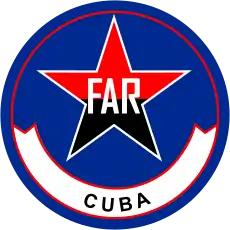 Cuban Revolutionary Armed Forces emblem | |
| Founded | 1959 |
| Current form | 1960 |
| Service branches |
|
| Headquarters | Havana, Cuba |
| Leadership | |
| First Secretary | Raúl Castro |
| Commander-in-chief | |
| Minister of the FAR | |
| Chief of the General Staff | |
| Manpower | |
| Military age | 17-28 years of age for compulsory military service |
| Conscription | 2-year service obligation for males |
| Available for military service | 3,134,622 males, age 15–49, 3,022,063 females, age 15–49 |
| Fit for military service | 1,929,370 males, age 15–49, 1,888,498 females, age 15–49 |
| Active personnel | 50,000 (2019 est.)[1] |
| Reserve personnel | 1,500,000[1] |
| Expenditures | |
| Percent of GDP | 3.08% (2015) |
| Industry | |
| Domestic suppliers | Union de Industrias Militares |
| Foreign suppliers | Former: (1958-89) |
| Related articles | |
| History | Escambray rebellion Bay of Pigs Invasion Sand War War of Attrition Yemenite War of 1972 Yom Kippur War Angolan Civil War Ogaden War |
| Ranks | Military ranks of Cuba |
| Military of Cuba |
|---|
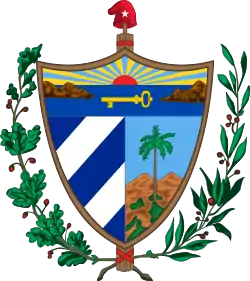 |
| Branches |
| Related articles |
The armed forces has long been the most powerful institution in Cuba.[2] The military manages many enterprises in key economic sectors representing about 4% of the Cuban economy.[3][4][5] The military has also served as First Secretary Raúl Castro's base.[5] In numerous speeches, Raúl Castro emphasized the military's role as a "people's partner".[6]
History
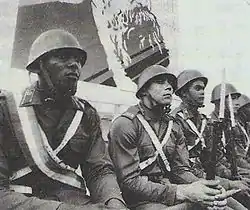
The Cuban Army in its original form was first established in 1895 by Cuban revolutionaries during the Cuban War of Independence.
During the Cold War, the Soviet Union granted both military and financial aid to the Cubans. From 1966 until the late 1980s, Soviet Government military assistance enabled Cuba to upgrade its military capabilities to number one in Latin America and project power abroad. The first Cuban military mission in Africa was established in Ghana in 1961. Cuba's military forces appeared in Algeria, in 1963, when a military medical brigade came over from Havana to support the government.[7] Since the 1960s, Cuba sent military forces to African and Arab countries – Syria in 1973, Ethiopia in 1978, the Cuban intervention in Angola from 1975 to 1989, and Nicaragua and El Salvador during the 1980s. The tonnage of Soviet military deliveries to Cuba throughout most of the 1980s exceeded deliveries in any year since the military build-up during the 1962 Cuban Missile Crisis.
In 1989, the government instituted a clean-up of the armed forces and the Ministry of Interior, convicting army Major General and Hero of the Republic of Cuba Arnaldo Ochoa, Ministry of Interior Colonel Antonio de la Guardia (Tony la Guardia), and Ministry of Interior Brigadier General Patricio de la Guardia on charges of corruption and drug trafficking. This judgment is known in Cuba as "Causa 1" (Cause 1). Ochoa and Antonio de la Guardia were executed. Following the executions, the Army was drastically downsized, the Ministry of Interior was moved under the informal control of Revolutionary Armed Forces chief General Raúl Castro (Fidel Castro's brother), and large numbers of army officers were moved into the Ministry of Interior.
The DIA reported in 1998 that the country's paramilitary organizations, the Territorial Militia Troops, the Youth Labor Army, and the Naval Militia had suffered considerable morale and training degradation over the previous seven years but still retained the potential to "make an enemy invasion costly."[8] Cuba also adopted a "war of the people" strategy that highlights the defensive nature of its capabilities.
On September 14, 2012, a Cuban senior general agreed to further deepen military cooperation with China during a visit to Beijing. He said that Cuba was willing to enhance exchanges with the Chinese military and strengthen bilateral cooperation in personnel training and other areas.[9]
Cuban military power was sharply reduced by the loss of Soviet subsidies following the end of the Cold War, and today the Revolutionary Armed Forces number 39,000 regular troops.[1]
Revolutionary Army (Ejercito Revolucionario)
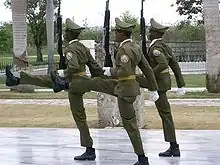
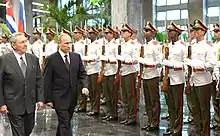
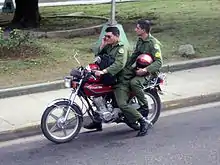
In 1984, according to Jane's Military Review, there were three major geographical commands, Western, Central, and Eastern.[10] There were a reported 130,000 all ranks, and each command was garrisoned by an army comprising a single armoured division, a mechanised division, and a corps of three infantry divisions, though the Eastern Command had two corps totalling six divisions. There was also an independent military region, with a single infantry division, which garrisoned the Isle of Youth.
A U.S. Defense Intelligence Agency assessment in the first half of 1998 said that the army's armour and artillery units were at low readiness levels due to 'severely reduced' training, generally incapable of mounting effective operations above the battalion level, and that equipment was mostly in storage and unavailable at short notice.[11] The same report said that Cuban special operations forces continue to train but on a smaller scale than beforehand, and that while the lack of replacement parts for its existing equipment and the current severe shortage of fuel were increasingly affecting operational capabilities, Cuba remained able to offer considerable resistance to any regional power.[12]
2002 organization
In 1999 the Revolutionary Army (Ejercito Revolucionario) represented approximately 70 percent of Cuba's regular military manpower. According to the IISS, the army's estimated 45,000 troops including 6,000 active and 39,000 members of the Ready Reserves who were completing the forty-five days of annual active-duty service necessary for maintaining their status, as well as conscripts who were fulfilling their military service requirement.[13]
The IISS reported in 1999 that the army's troop formations consisted of four to five armored brigades; nine mechanized infantry brigades; an airborne brigade; fourteen reserve brigades; and the Border Brigade. In addition, there is an air defense artillery regiment and a surface-to-air missile brigade. Each of the three territorial armies is believed to be assigned at least one armored brigade-usually attached to the army's headquarters-as well as a mechanized infantry brigade. As well, it is known that the Border Brigade in Guantanamo and at least one ground artillery regiment (attached to a mechanized infantry brigade), based in Las Tunas, are under the Eastern Army's command.[13]
1996 organization
In 1996, according to Jane's Information Group, the army was organized into three Territorial Military Commands with three Armies, one army for each command.[14] At the time, there were an estimated 38,000 army personnel.[15]
Revolutionary Army Command:
- Airborne brigade consisting of 2 battalions (at Havana and its immediate environs)
- Artillery division (at Havana and its immediate environs)
- SAM Brigade[16]
- An anti-aircraft artillery regiment[16]
Western Army (deployed in the capital and the provinces of Havana and Pinar del Río)
- 1st Armored Training Division
- 70th Mechanised Division
- 78th Armored Division "Sanguily Rescue"
2nd (Pinar del Río) Army Corps:
- 24th Infantry Division
- 27th Infantry Division
- 28th Infantry Division
Central Army (Provinces of Matanzas, Villa Clara, Cienfuegos and Sancti Spiritus)
- 81st Infantry Division
- 84th Infantry Division
- 86th Infantry Division
- 89th Infantry Division
- 12th Armored Regiment/1st Armored Division
- 242nd Infantry Regiment/24th Infantry Division
4th (Las Villas) Army Corps:
- 41st Infantry Division
- 43rd Infantry Division
- 48th Infantry Division
Eastern Army (Provinces of Santiago de Cuba, Guantánamo, Granma, Holguín,
Las Tunas, Camagüey and Ciego de Avila)
- 3rd Armored Division
- 6th Armored Division
- 9th Armored Division
- 31st Infantry Division
- 32nd Infantry Division
- 38th Infantry Division
- 84th Infantry Division
- 90th Infantry Division
- 95th Infantry Division
- 97th Infantry Division
- Guantanamo Frontier Brigade
- 123rd Infantry Division/former 12th Infantry Division
- 281st Infantry Regiment/28th Infantry Division
5th (Holguín) Army Corps:
- 50th Mechanised Division
- 52nd Infantry Division
- 54th Infantry Division
- 56th Infantry Division
- 58th Infantry Division
6th (Camagüey) Army Corps:
- 60th Mechanised Division
- 63rd Infantry Division
- 65th Infantry Division
- 69th Infantry Division
Small Arms
| Name | Country of origin | Type | Notes |
|---|---|---|---|
| PM | Semi-automatic pistol | Standard issue pistol. | |
| APS | Machine pistol | Used by Special Forces | |
| APS underwater rifle | Underwater assault rifle | In use with Special Forces. | |
| SKS | Semi-automatic carbine | Mostly limited to use as a ceremonial weapon. | |
| AKM | Assault rifle | Standard issue assault rifle. | |
| RPK | Light machine gun | ||
| SG-43 | Medium machine gun | ||
| KPV | Heavy machine gun | ||
| PKM | General-purpose machine gun | ||
| PM-63 RAK | Submachine gun | Used by some MTT units. | |
| M16A1 | Assault rifle | Possibly captured sometime during the Cold War. | |
| SVD | Semi-automatic sniper rifle | ||
| Alejandro Sniper Rifle | Bolt-action sniper rifle | ||
| Mambi AMR | Anti-material rifle | ||
| RPG-7 | Rocket-propelled grenade | ||
| SPG-9 | Recoilless gun | ||
| AGS-17 | Automatic grenade launcher | ||
| LPO-50 | Flamethrower | ||
| RGD-5 | Hand grenade | ||
| F1 |
Light and medium tanks
| Name | Country of origin | Quantity | Notes |
|---|---|---|---|
| PT-76 | 50 | [17] |
Main battle tanks
| Name | Country of origin | Quantity | Notes |
|---|---|---|---|
| T-54/55 | 800 | T-55Ms active[17] | |
| T-62 | 380 | T-62Ms active[17] |
Reconnaissance armoured vehicles
| Name | Country of origin | Quantity | Notes |
|---|---|---|---|
| BRDM-2 | 100 |
Infantry fighting vehicles
| Name | Country of origin | Quantity | Notes | |
|---|---|---|---|---|
| BMP-1 | 120[18] |
Armoured personnel carriers
| Name | Country of origin | Quantity | Notes |
|---|---|---|---|
| BTR-40 | 100 | ||
| BTR-50 | 200 | ||
| BTR-60 | +800 | Various versions of this vehicle. Including one with a 100 mm gun and a modified T-55 turret. | |
| BTR-70 | ?? | ||
| BTR-152 | 150 |
Towed artillery
| Name | Country of origin | Quantity | Notes |
|---|---|---|---|
| A-19 | |||
| D-20 | |||
| D-30 | Mostly used as guns for self-propelled artillery together with modernized A-19 122 mm. | ||
| M-30 | Used as saluting guns firing 21-gun salutes. | ||
| M-46 | This 130mm long range gun is used also as a self-propelled artillery piece in 6x6 truck called Jupiter-V and there is also a version mounted on a T-34 chassis. |
Self-propelled artillery
| Name | Country of origin | Quantity | Notes |
|---|---|---|---|
| 2S1 Gvozdika | 60 | ||
| 2S3 Akatsiya | 40 |
Multi rocket launchers
| Name | Country of origin | Quantity | Notes |
|---|---|---|---|
| BM-21 | |||
| P-15 Termit |
Mortars
| Name | Country of origin | Quantity | Notes |
|---|---|---|---|
| M-38/43 | |||
| M-41/43 |
Anti-tank weapons
| Name | Country of origin | Quantity | Notes |
|---|---|---|---|
| AT-3 Sagger | Mounted on the BTR-60 | ||
| AT-4 Spigot | |||
| T-12 |
Anti-aircraft guns
| Name | Country of origin | Quantity | Notes |
|---|---|---|---|
| ZPU-4 | 200 | ||
| ZU-23-2 | 400 | ||
| ZSU-23-4 | 36 | ||
| ZSU-57-2 | 25 | ||
| KS-19 | |||
| M-1939 | 300 | ||
| S-60 | 200 |
SAMs
| Name | Country of origin | Quantity | Notes |
|---|---|---|---|
| SA-6 Gainful | 12 | ||
| SA-7 Grail | |||
| SA-8 Gecko | 16 | ||
| SA-9 Gaskin | 60 | ||
| SA-13 Gopher | 100 | ||
| SA-14 Gremlin | |||
| SA-16 Gimlet | |||
| S-75 Dvina | 144 | ||
| S-125 Neva/Pechora | 60 |
Self-propelled SAMs
| Name | Country of origin | Quantity | Notes |
|---|---|---|---|
| S-75 Dvina | 25 | On T-55 chassis. | |
| S-125 Neva/Pechora | On T-55 chassis. This missile was seen in the Cuban Military Parade of 2006. |
Cuban Revolutionary Air and Air Defense Force
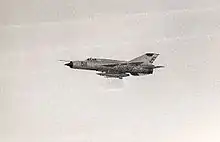
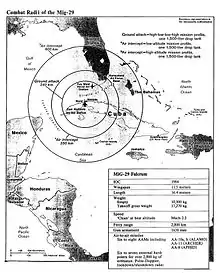
The Cuban Revolutionary Air and Air Defense Force (Spanish: Defensa Anti-Aérea Y Fuerza Aérea Revolucionaria) commonly abbreviated to DAAFAR in both Spanish and English, is the air force of Cuba.
Former aircraft include: MiG-15, MiG-17, MiG-19, North American B-25 Mitchell, North American P-51 Mustang, and the Hawker Sea Fury
In the 1980s, Cuba with the help of the Soviet Union was able to project power abroad, using its air force, especially in Africa. During that time Cuba sent jet fighters and transports for deployment in conflict zones such as Angola and Ethiopia.
In 1990, Cuba's Air Force was the best equipped in Latin America. In all, the modern Cuban Air Force imported approximately 230 fixed-wing aircraft. Although there is no exact figure available, Western analysts estimate that at least 130 (with only 25 operational[19]) of these planes are still in service spread out among the thirteen military airbases on the island.
In 1996, fighters from the DAAFAR shot down two Cessna aircraft based in Florida which were incorrectly suspected of dropping leaflets into Cuban airspace. The air force was criticised for not giving the pilots of the aircraft options other than being shot down. One aircraft escaped.[20]
In 1998, according to the same DIA report mentioned above, the air force had 'fewer than 24 operational MIG fighters; pilot training barely adequate to maintain proficiency; a declining number of fighter sorties, surface-to-air missiles and air-defense artillery to respond to attacking air forces.[21]
By 2007 the International Institute for Strategic Studies assessed the force as 8,000 strong with 41 combat capable aircraft and a further 188 stored. DAAFAR is known now to have integrated another MiG-29 and a few MiG-23s which makes it 58 combat aircraft in active service which are listed as 6 MiG-29s, 40 MiG-23s, and 12 MiG-21s. There were also assessed to be 12 operational transport aircraft plus trainers which include 8 L-39C and helicopters which are mainly Mil Mi-8, Mil Mi-17 and Mil Mi-24 Hind. Raúl Castro ordered in 2010 that all MiG-29 pilots had to have full training, they now have from 200–250 hours of flight annually together with real dogfight training and exercises. Up to 20 MiG-23 units also have this kind of training but the other 16 MiG-23 units spend more time in simulators than real flight. MiG-21 units have limited time in these training exercises and spend more time in simulators and maintain their skills flying with the commercial brand of the air force Aerogaviota.
At San Antonio de los Baños military air field, south west of Havana, several aircraft are visible using Google Earth.[22]
Cuban Revolutionary Navy (Marina de Guerra Revolucionaria, MGR)
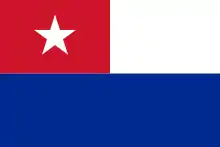

In 1988, the Cuban Navy boasted 12,000 men, three submarines, two modern guided-missile frigates, one intelligence vessel, and a large number of patrol craft and minesweepers.[23] However, most of the Soviet-made vessels have been decommissioned or sunk to make reefs. By 2007, the Cuban Navy was assessed as being 3,000 strong (including up to 550+ Navy Infantry) by the IISS with six Osa-II and one Pauk-class corvette. The Cuban Navy also includes a small marine battalion called the Desembarco de Granma. It once numbered 550 men though its present size is not known.
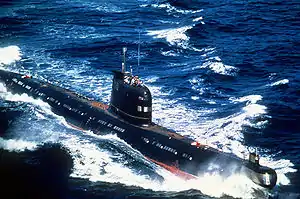
After the old Soviet submarines were put out of service, Cuba searched for help from North Korea's experience in midget submarines. North Korean defectors claimed to have seen Cubans in mid to late 1990s in a secret submarine base and appeared in public view years later a single picture of a small black native submarine in Havana harbour. It is rumored to be called 'Delfin' and is to be armed with two torpedoes. Only a single boat is in service and the design appears original, even if influenced both by North Korea and Soviet designs.[24][25]
The Cuban Navy rebuilt one, large ex-Spanish Rio Damuji fishing boat. BP-390 is now armed with two C-201W missiles, one twin 57 mm gun mount, two twin 25 mm gun mounts and on 14.5 mm machine gun. This vessel is larger than the Koni class, and it is used as a helicopter carrier patrol vessel. A second unit (BP-391) was converted and entered service in 2016.[26]
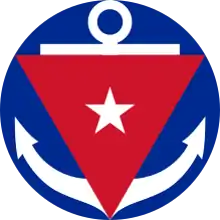
The Cuban Navy today operates its own missile systems, the made-in-Cuba Bandera (a copy of the dated Styx Soviet missiles) and Remulgadas anti-ship missile systems, as well as the nationally produced Frontera self-propelled coastal defence multiple rocket launcher. The navy's principal threats are drug smuggling and illegal immigration. The country's geographical position and limited naval presence has enabled traffickers to utilise Cuban territorial waters and airspace.[27]
The Cuban Navy's air wing is an ASW helicopter operator only and is equipped with 2 MI-14 Haze helicopters.[28]
Air and Naval air bases
- Active bases
- Cabañas (HQ Western Command) – San Julián Air Base (MUSJ)
- 23rd Regiment (Mikoyan-Gurevich MiG-23ML)
- Primary Training (Antonov An-2)
- 1650 Combat Training (Mikoyan-Gurevich MiG-21UM)
- Combat Training Squadron (Mikoyan-Gurevich MiG-21PFMA and Mikoyan-Gurevich MiG-21MF)
- Rwy 01/19 2041 m (6695 ft)
- Rwy 08/26 2584 m (8479 ft)
- Naval Base?
- Alameda del Siboney
- 23° 5'25"N, 82°28'45"W and 22°58'45"N, 82°59'15"W
- Holguín (HQ Eastern Command) – Frank País Airport (MUHG)
- 1724 Interceptor Regiment (Mikoyan-Gurevich MiG-23BN bomber)
- 3710 Interceptor Squadron and Training
- 34th Tactical Regiment
- Naval Base?
- Havana – Playa Baracoa Airport (MUPB)
- 3405th Executive Squadron
- 3404 Transport Squadron
- 3688 Transport Regiment
- Havana – José Martí Airport (MUHA)
- 25th Transport Regiment (Ilyushin Il-76 and Antonov An-32)
- Rwy 06/24, Size: 4001 m (13,125 ft)
- La Coloma Airport (MULM)
- 1660 Training Squadron (Aero L-39 AlbatrosC)
- Casablanca, Havana naval base
- homeport for the navy's two frigates
- there are naval facilities in Cienfuegos (patrol vessels docked near Museo Historico Naval Nacional in Cayo Loco area), Mariel (near shipyard/container port), Nicaro and Punta Movida.
- Inactive bases
- Mariel – Mariel Airfield (MUML) – now container terminal
- former anti-submarine helicopter squadron (Ka-32 and Mil Mi-14PL)
- Campo de Columbia – renamed Campo Libertad in 1961 (MULB)
- 26th Transport Regiment (Mil Mi-2 and Mil Mi-8)
- Training Squadron (Aero L-39 AlbatrosC and Z-326T)
- 2065 m (6775 ft runway)
- Campo Teniente Brihuega
- Playa Baracoa – Playa Baracoa Airfield (MUPB)
- 22nd Regiment
- Nicaro Airport (MUNC)
- abandoned airfield 1315 m (single 4314 ft runway)
- Punta Movida
- Soviet built base
- Cienfuegos Airport (Jaime González Air Station) (MUCF)
- single 2/20 runway 1510 m (4954 ft)
- 15th Transport Regiment (Antonov An-2 and Antonov An-26)
- 16th Helicopter Regiment (Mil Mi-8, Mil Mi-14, Mil Mi-17)
- Güines
- 24 Tactical Regiment (Mikoyan-Gurevich MiG-23BN)
- Santiago de Cuba – Antonio Maceo Airport (MUCU)
- 35th Transport Regiment (Antonov An-2 and Antonov An-26)
- 36 Helicopter Regiment (Mil Mi-8 and Mil Mi-24)
- Rwy 09/27 4000 m (13123 ft)
- Rwy 18/36 1296 m (4252 ft)
- San Antonio de los Baños Airport (MUSA)
- 21st Regiment (Mikoyan-Gurevich MiG-21B)
- 1724 Regiment
- 3 Runways
- Rwy 01/19 2400 m (7873 ft)
- Rwy 05/23 3596 m (11,799 ft)
- Rwy 12/30 2482 m (8144 ft)
- Santa Clara – Abel Santa María Airport (MUSC)
- 14th Tactical Regiment (Mikoyan-Gurevich MiG-23BN) bomber
- Rwy 08/26 3017 m (9898 ft)
- Santa Cruz
- 11 Regiment (Mikoyan-Gurevich MiG-21B)
- Sancti Spíritus – Sancti Spiritus Airport (MUSS)
- 12th Regiment (Mikoyan-Gurevich MiG-21MF)
- Rwy 03/21 1801 m (5908 ft)
- Camagüey – Ignacio Agramonte Airport (MUCM)
- 31st Regiment – Mikoyan-Gurevich MiG-21MF fighters
- Rwy 07/25 3000 m (9842 ft)
Fleet equipment
- 2 Rio Damuji-class frigates, 1 × 57 mm gun, 2 Styx surface-to-surface missiles, 1 × 12.7 mm machine gun, 2 × 25 mm machine guns.
- 1 Delfin-class midget submarines, possibly 2 torpedo launchers. Rumored derived from North Korean Yugo-class submarine.[24]
- 1 Pauk II-class fast patrol craft, Coastal with 1 × 76 mm gun, 4 anti-submarine torpedo tubes, 2 anti-submarine weapon rocket launcher – 495 tons full load – commissioned 1990.
- 6 former Soviet Union (FSU) Osa II-class PFM missile boats; 13 Type II transferred.
- 3 ex-Soviet Union (FSU) Sonya-class minesweepers; 4 transferred.
- 5 Former Soviet Union (FSU) Yevgenya-class minesweeper; 11 transferred.
- 1 Intelligence collection vessel.
Ground forces organization
- 2 amphibious assault battalions.
- 1 coastal defense field artillery regiment
- 1 coastal defense missile artillery regiment
- 1 light armored battalion (amphibious)
Naval Ground forces equipment
- 122 mm artillery.
- M-1931/3 artillery.
- 130 mm: M-46 artillery.
- 152 mm: M-1937 artillery.
- ≈10 SSC-3 surface-to-surface missile systems.
- 18–24 Remulgadas coastal defense surface multiple missile launchers
- 20 Bandera coastal defense surface multiple missile launchers
- 12 RBU-6000 Frontera coastal defense multiple rocket launchers
- 18–22 PT-76 light tanks
Naval Aviation aircraft
| Aircraft | Origin | Type | Notes |
|---|---|---|---|
| Mil Mi-14 | USSR | ASW | 2 |
The border guards have: 2 Stenka class patrol boats and as of 2007 approximately a dozen, down from 30/48, Zhuk patrol craft. Cuba makes Zhuk patrol craft and some are seen with an SPG-9 mounted on front of the twin 30mm guns.[29] [30]
Historic
- 1 Soviet Foxtrot-class submarine with 533 mm and 406 mm torpedo tube (non-operational); 3 transferred
- 3 Soviet Koni-class corvettes with 2 Anti-Submarine Weapon Rocket Launcher (non-operational); 3 transferred
- 4 Soviet Osa I/II-class missile boats with 4 SS-N-2 Styx surface-to-surface missile+
- 1 Soviet Pauk II-class fast patrol craft, coastal with 2 anti-submarine weapon rocket launcher, 4 anti-submarine torpedo tube
- 1 Soviet/Polish Polnocny-class medium landing ship, capacity 180 troops, 6 tanks (non-operational)
Military schools
- Máximo Gómez Command Academy – succeeded the El Morro Academy, current command college of the CRAF
- National Defense College of Cuba
- Camilo Cienfuegos Military Schools System – founded 1962, with 20 campuses in many cities, official military high school
- Jose Maceo Military College – officer cadet school of the Ground Force
- Antonio Maceo Military College
- Granma Naval Academy
- Jose Marti Military Technical Institute – current officer cadet school of the technical services and the Air Force
- Military Medical University of Cuba
- Arides Sánchez Military Justice School
References
- International Institute for Strategic Studies: The Military Balance 2015, p. 392
- "The Cuban military and transition dynamics" (PDF). Archived from the original (PDF) on 2009-03-26. Retrieved 2009-08-27.
- "Does the Cuban Military Really Control Sixty Percent of the Economy?". Huffington Post. 2017-06-28.
- "Challenges to a Post-Castro Cuba" (PDF). Harvard International Review. Archived from the original (PDF) on 2010-06-10. Retrieved 2009-08-27.
- Carl Gershman and Orlando Gutierrez (January 2009). "Can Cuba Change?" (PDF). Journal of Democracy. 20 (1).
- Claudia Zilla. "The Outlook for Cuba and What International Actors Should Avoid" (PDF).
- John Williams, "Cuba: Havana's Military Machine", The Atlantic, August 1988
- Bryan Bender, 'DIA expresses concern over Cuban intelligence activity,' Jane's Defence Weekly, 13 May 1998, p. 7
- Cuba and China strengthen military cooperation – Armyrecognition.com, September 16, 2012
- English, Adrian J., "The Cuban Revolutionary Armed Forces," in Ian V. Hogg (Ed.), Jane's Military Review, Jane's Publishing Company, 1985.
- Bryan Bender, 'DIA expresses concern over Cuban intelligence activity', Jane's Defence Weekly, 13 May 1998, p. 7
- "The World Factbook". Retrieved 24 April 2016.
- "About this Collection" (PDF). The Library of Congress. Retrieved 24 April 2016.
- "Cuban Armed Forces Review: Territorial Military Commands". Archived from the original on 12 January 2008. Retrieved 24 April 2016.
- IISS Military Balance 2007, p. 70
- "Armies of the world Arsenal". Retrieved 24 April 2016.
- "Cuban Tanks". Cuban Aviation • Rubén Urribarres. Retrieved 24 April 2016.
- International Institute for Strategic Studies: The Military Balance 2015, p. 393
- Cuban Armed Forces Review: Air Force Archived 2009-02-10 at the Wayback Machine
- Sections 3.18, 3.19 and 3.20 of the Resolution on the Cuban Government's Shootdown of Brothers to the Rescue Adopted by the Council of the International Civil Aviation Organization (ICAO) at the Twentieth Meeting of its 148th Session on 27 June 1996
- Jane's Defence Weekly, 13 May 1998
- https://maps.google.com/maps?hl=en&q=22+52%2728.40%22+N+82+30%2726.04%22+W&ll=22.874643,-82.506809&spn=0.004557,0.006899&t=h&z=17 Google Earth imagery of San Antonio de los Baños airfield
- "Cuba: Havana's Military Machine". August 1988.
- "Delfin". hisutton.com. 10 October 2016. Retrieved 4 January 2018.
- Sutton, H. I. "New Photo Reveals Cuban Navy's Secret Submarine". Forbes. Retrieved 2020-03-02.
- = Un baluarte sobre el mar "Un baluarte sobre el mar" Check
|url=value (help). granma. 28 August 2017. Retrieved 4 January 2018. - "Global Security on Cuban Navy".
- Cuban Armed Forces Review: Air Force Archived 2009-02-10 at the Wayback Machine.
- "Zhuk class". Retrieved 9 December 2012.
- "Cuban Border Guard". Retrieved 9 December 2012.
Further reading
- Jane's Intelligence Review, June 1993
- Piero Gleijeses: Kuba in Afrika 1975–1991. In: Bernd Greiner /Christian Th. Müller / Dierk Walter (Hrsg.): Heiße Kriege im Kalten Krieg. Hamburg, 2006, ISBN 3-936096-61-9, S. 469–510. (Review by H. Hoff, Review by I. Küpeli)
- Defense Intelligence Agency, HAndbook on the Cuban Armed Forces, DDB-2680-62-79, April 1979
External links
| Wikimedia Commons has media related to Cuban Revolutionary Armed Forces. |
- (in Spanish) Official site of the Revolutionary Armed Forces
- Foro Militar General (Cuban military forum)
- (in Spanish) Cuban Air Force
- (in Spanish) Secretos de Generales on Granma site
- Cuban Armed Forces Review
- Latin American Light Weapons National Inventories
- Map showing AFBs in Cuba